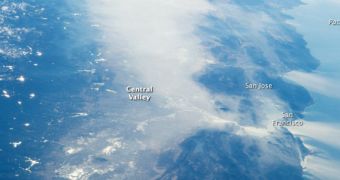The image above was collected by Expedition 38 crew members aboard the International Space Station (ISS) on January 17, 2014, and shows a large part of California covered in haze. Earlier in the year, and at the very end of 2013, this entire region was blanketed in winter fog, even though the state was and still is plagued by drought.
The recent photograph was centered on the southern half of Central Valley in California. Experts say that this area regularly experiences dense, white fog, especially during the winter. During clear nights, the ground cools very fast, chilling the air to the point where water vapors can condense near ground levels. On some occasions, several days may pass before the fog clears altogether.
However, this did not happen on January 17, and a host of other dates in 2014, due to a significant lack of water throughout the state. “Because of the drought, we have had a very limited fog season this year. Poor to very poor air quality has been a problem this winter due to a lack of rain and stagnant air,” says National Weather Service meteorologist Paul Iñiguez.
Throughout the day, air quality levels in Central Valley ranged from unhealthy to very unhealthy, astronauts aboard the ISS determined. EPA standards for fine particulate pollution, of 35 micrograms per cubic meter each day, were severely exceed, with the Jan Joaquin Valley Air Pollution Control District recording a FPP level of 74 micrograms per cubic meter.

 14 DAY TRIAL //
14 DAY TRIAL //